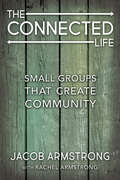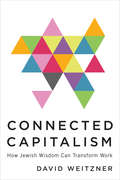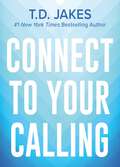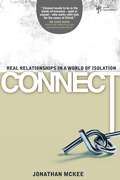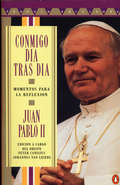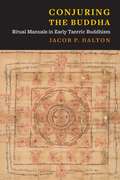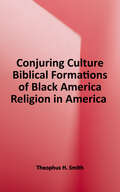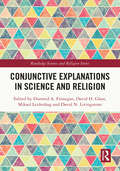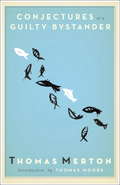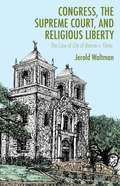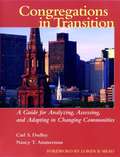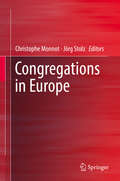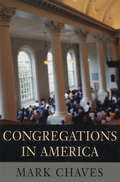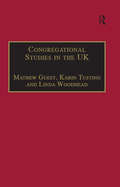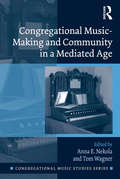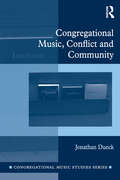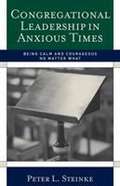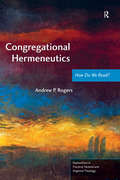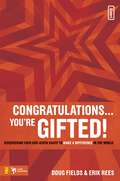- Table View
- List View
The Connected Life: Small Groups That Create Community
by Jacob ArmstrongHow can our church develop or improve our small group ministry? This book is a useful how-to guide, based on the innovative, engaging, and popular approach to small group ministry at Providence United Methodist Church, where Jacob Armstrong is senior pastor.
The Connected Life: The Art and Science of Relational Spirituality
by Todd W. HallIt's no secret that we live in an increasingly isolated world.The Connected LifeHere is a wise, accessible introduction to transformative relational connection, addressing the deeply felt disconnection in our society and inviting us into lasting relationships with God and others.
The Connected Discourses of the Buddha: A New Translation of the Samyutta Nikaya (The Teachings of the Buddha)
by Bhikkhu BodhiThis volume offers a complete translation of the Samyutta Nikaya, The Connected Discourses of the Buddha, the third of the four great collections in the Sutta Pitaka of the Pali Canon. The Samyutta Nikaya consists of fifty-six chapters, each governed by a unifying theme that binds together the Buddha's suttas or discourses. The chapters are organized into five major parts. The first, The Book with Verses, is a compilation of suttas composed largely in verse. This book ranks as one of the most inspiring compilations in the Buddhist canon, showing the Buddha in his full grandeur as the peerless "teacher of gods and humans." The other four books deal in depth with the philosophical principles and meditative structures of early Buddhism. They combine into orderly chapters all the important short discourses of the Buddha on such major topics as dependent origination, the five aggregates, the six sense bases, the seven factors of enlightenment, the Noble Eightfold Path, and the Four Noble Truths. Among the four large Nikayas belonging to the Pali Canon, the Samyutta Nikaya serves as the repository for the many shorter suttas of the Buddha where he discloses his radical insights into the nature of reality and his unique path to spiritual emancipation. This collection, it seems, was directed mainly at those disciples who were capable of grasping the deepest dimensions of wisdom and of clarifying them for others, and also provided guidance to meditators intent on consummating their efforts with the direct realization of the ultimate truth. The present work begins with an insightful general introduction to the Samyutta Nikaya as a whole. Each of the five parts is also provided with its own introduction, intended to guide the reader through this vast, ocean-like collection of suttas. To further assist the reader, the translator has provided an extensive body of notes clarifying various problems concerning both the language and the mean
Connected Capitalism: How Jewish Wisdom Can Transform Work
by David WeitznerIn our present state of disconnect and loss, Connected Capitalism offers us a deeper and more satisfying approach to both work and life. What should our post-COVID work world look like? In Connected Capitalism, David Weitzner shows us how to draw from the classic teachings of Judaism in order to positively transform our workplaces and our working lives. He outlines a philosophy that will empower the disenchanted to build a stable future in a world of crony capitalism, global pandemics, racial injustice, and social disconnect. Weitzner, a professor of management who chooses to look beyond management and mindfulness, envisions a workplace based on the ancient Jewish practices of mitzvah, creating a space for meaningful moments with other people, and chavrusa, co-creating and working on endeavors together. Combining these spiritual concepts with the voices of today’s political strategists, business leaders, and artists, Connected Capitalism inspires us to approach our work with curiosity, engage with those who were once strangers, and tap into a hopeful and meaningful future.
Connect to Your Calling Digest
by T. D. JakesBestselling author Bishop T.D. Jakes shares this essential guide to recognizing, understanding, and utilizing your spiritual instincts to find God's calling in your life. Instant smash hit and #1 New York Times bestseller for six weeks, Bishop T.D. Jakes' Instinct showed readers how to tap into their intuition to achieve ultimate success. Now, you can apply those lessons with this collection, designed to encourage you on your faith journey. Combining social, business, and personal examples with biblical insights, this personal application guide will show you how to rediscover your natural aptitudes and reclaim the wisdom of past experiences. Knowing when to close a deal, when to take a risk, and when to listen to your heart will become possible when you're in touch with the instincts that God gave you. If you're ready to unlock your destiny and discover where you were meant to go, then this book is your key!
Connect: Real Relationships in a World of Isolation
by Jonathan Mckee"In an age where teenagers are deeply engaged in virtual communities and social networks, they’re still feeling alone and isolated. It may sound all too simple, but the truth is that you have the opportunity to make a profound impact on the lives of students with the simple act of spending time with them, one-on-one. Whether you’re a volunteer or the lead youth pastor, getting some students to open up and share their lives can be a challenge. In this practical book you’ll learn the importance of connecting with students on an individual basis and get helpful ideas on how to engage a variety of students in meaningful dialogue. You’ll explore and learn more about connecting with six different types of students, including: • The “No Way” Kid • The “Not Interested” Kid • The “Checking Things Out Kid” • The “Stagnant” Kid • The “Growing” Kid • The “Looking for Ministry” Kid Connect will walk you through the steps to lead you into relationships with students that go beyond the youth room and impact them into adulthood."
Conmigo día tras día: Momentos para la reflexion
by John Paul Peter Canisius Johannes van Li Antonio Aramayono AlonsoMore information to be announced soon on this forthcoming title from Penguin USA
Conjuring the Buddha: Ritual Manuals in Early Tantric Buddhism
by Jacob P. DaltonRitual manuals are among the most common and most personal forms of Buddhist literature. Since at least the late fifth century, individual practitioners—including monks, nuns, teachers, disciples, and laypeople—have kept texts describing how to perform the daily rites. These manuals represent an intimate counterpart to the canonical sutras and the tantras, speaking to the lived experience of Buddhist practice.Conjuring the Buddha offers a history of early tantric Buddhist ritual through the lens of the Tibetan manuscripts discovered near Dunhuang on the ancient Silk Road. Jacob P. Dalton argues that the spread of ritual manuals offered Buddhists an extracanonical literary form through which to engage with their tradition in new and locally specific ways. He suggests that ritual manuals were the literary precursors to the tantras, crucial to the emergence of esoteric Buddhism. Examining a series of ninth- and tenth-century tantric manuals from Dunhuang, Dalton uncovers lost moments in the development of rituals such as consecration, possession, sexual yoga, the Great Perfection, and the subtle body practices of the winds and channels. He also traces the use of poetic language in ritual manuals, showing how at pivotal moments, metaphor, simile, rhythm, and rhyme were deployed to evoke carefully sculpted affective experiences. Offering an unprecedented glimpse into the personal practice of early tantric Buddhists, Conjuring the Buddha provides new insight into the origins and development of the tantric tradition.
Conjuring Culture: Biblical Formations of Black America (Religion In America Ser.)
by Theophus H. SmithThis book provides a sophisticated new interdisciplinary interpretation of the formulation and evolution of African American religion and culture. <p><p>Theophus Smith argues for the central importance of "conjure"—a magical means of transforming reality—in black spirituality and culture. Smith shows that the Bible, the sacred text of Western civilization, has in fact functioned as a magical formulary for African Americans. <p><p>Going back to slave religion, and continuing in black folk practice and literature to the present day, the Bible has provided African Americans with ritual prescriptions for prophetically re-envisioning, and thereby transforming, their history and culture. In effect, the Bible is a "conjure book" for prescribing cures and curses, and for invoking extraordinary and Divine powers to effect changes in the conditions of human existence—and to bring about justice and freedom. Biblical themes, symbols, and figures like Moses, the Exodus, the Promised Land, and the Suffering Servant, as deployed by African Americans, have crucially formed and reformed not only black culture but American society as a whole. <p><p>Smith examines not only the religious and political uses of conjure, but its influence on black aesthetics, in music, drama, folklore, and literature. The concept of conjure, he shows, is at the heart of indigenous and still vital spirituality, with exciting implications for reformulating the next generation of black studies and black theology. Even more broadly, Smith proposes, "conjuring culture" can function as a new paradigm for understanding Western religious and cultural phenomena generally.
Conjunctive Explanations in Science and Religion (Routledge Science and Religion Series)
by David H. Glass Mikael Leidenhag David N. LivingstoneThis book investigates the nature and relevance of conjunctive explanations in the context of science and religion. It explores questions concerning how scientific and religious explanations for features of the world or phenomena within it relate to each other and whether they might work together in mutually enriching ways. The chapters address topics including the relationship between Darwinian and teleological explanations, non-reductive explanations of mind and consciousness, and explanations of Christian faith and religious experience, while others explore theological and philosophical issues concerning the nature and feasibility of conjunctive explanations. Overall, the contributions help to provide conceptual clarity on how scientific and religious explanations might or might not work together conjunctively as well as exploring how these ideas relate to specific topics in science and religion more generally.
Conjectures of a Guilty Bystander
by Thomas MertonIn this series of notes, opinions, experiences, and reflections, Thomas Merton examines some of the most urgent questions of our age. With his characteristic forcefulness and candor, he brings the reader face-to-face with such provocative and controversial issues as the “death of God,” politics, modern life and values, and racial strife–issues that are as relevant today as they were fifty years ago. Conjectures of a Guilty Bystanderis Merton at his best–detached but not unpassionate, humorous yet sensitive, at all times alive and searching, with a gift for language which has made him one of the most widely read and influential spiritual writers of our time.
Conjectures of a Guilty Bystander
by Thomas Moore Thomas MertonIn this series of notes, opinions, experiences, and reflections, Thomas Merton examines some of the most urgent questions of our age. With his characteristic forcefulness and candor, he brings the reader face-to-face with such provocative and controversial issues as the "death of God," politics, modern life and values, and racial strife-issues that are as relevant today as they were fifty years ago. Conjectures of a Guilty Bystander is Merton at his best-detached but not unpassionate, humorous yet sensitive, at all times alive and searching, with a gift for language which has made him one of the most widely read and influential spiritual writers of our time.From the Trade Paperback edition.
Conjectures of a Guilty Bystander
by Thomas Moore Thomas MertonIn this series of notes, opinions, experiences, and reflections, Thomas Merton examines some of the most urgent questions of our age. With his characteristic forcefulness and candor, he brings the reader face-to-face with such provocative and controversial issues as the "death of God," politics, modern life and values, and racial strife-issues that are as relevant today as they were fifty years ago. Conjectures of a Guilty Bystander is Merton at his best-detached but not unpassionate, humorous yet sensitive, at all times alive and searching, with a gift for language which has made him one of the most widely read and influential spiritual writers of our time.From the Trade Paperback edition.
Congress, the Supreme Court, and Religious Liberty
by Jerold WaltmanIn the case City of Boerne v. Flores, the Supreme Court struck down the Religious Freedom Restoration Act of 1993. Waltman offers the first book-length analysis of the act to show how this case contributes to an intense legal debate still ongoing today: Can and should the Supreme Court be the exclusive interpreter of the Constitution?
Congregations in Transition: A Guide for Analyzing, Assessing, and Adapting in Changing Communities
by Carl S. Dudley Nancy T. AmmermanThis hands-on guide helps congregations meet the reality and challenges of today's constantly changing urban and suburban church communities. Congregations in Transition, written in an easy-to-follow workbook format, is designed to help communities of faith focus on the changing needs of their members and explore the opportunities and options open to them.
Congregations in Europe
by Jörg Stolz Christophe MonnotThis volume describes and maps congregations of Christian confessions and denominations, as well as groups with Jewish, Buddhist, Muslim, Hindu, and various other spiritual faiths, in different European countries. Consisting of three parts, it presents concrete sociological studies addressing how established and not established, old and new congregations of various faiths create a new kind of religious diversity at the country level; how religious congregations are challenged and thrive in large cities; and how religious congregations change in the 21st century. The book enlightens by its descriptive analysis and the theoretical questions it raises concerning the religious transformations happening all over Europe. It addresses issues of religious diversity in the cities of Europe by presenting large studies conducted in cities such as Barcelona in Spain, and Aarhus in Denmark. By means of large-scale censuses taken in areas such as North Rhine-Westphalia in Germany and in countries like Switzerland and Italy, the book shows how the historically established churches restructure their congregations and activities. It clarifies for the new gatherers where and how a new diversity of religious congregations is in the process of being established. Finally, the book covers two important topical issues: pluralisation and secularisation. It provides new data on religious diversity, painting a new picture of secularisation: the impact and structural consequences of the long-term decrease of membership in the established churches.
Congregations in America
by Mark ChavesMore Americans belong to religious congregations than to any other kind of voluntary association. What these vast numbers amount to--what people are doing in the over 300,000 churches, synagogues, mosques, and temples in the United States--is a question that resonates through every quarter of American society, particularly in these times of "faith-based initiatives," "moral majorities," and militant fundamentalism. And it is a question answered in depth and in detail in Congregations in America. Drawing on the 1998 National Congregations Study--the first systematic study of its kind--as well as a broad range of quantitative, qualitative, and historical evidence, this book provides a comprehensive overview of the most significant form of collective religious expression in American society: local congregations. Among its more surprising findings, Congregations in America reveals that, despite the media focus on the political and social activities of religious groups, the arts are actually far more central to the workings of congregations. Here we see how, far from emphasizing the pursuit of charity or justice through social services or politics, congregations mainly traffic in ritual, knowledge, and beauty through the cultural activities of worship, religious education, and the arts. Along with clarifying--and debunking--arguments on both sides of the debate over faith-based initiatives, the information presented here comprises a unique and invaluable resource, answering previously unanswerable questions about the size, nature, make-up, finances, activities, and proclivities of these organizations at the very center of American life.
Congregational Studies in the UK: Christianity in a Post-Christian Context (Explorations in Practical, Pastoral and Empirical Theology)
by Karin TustingThis book presents the first comprehensive introduction to congregational studies in the UK. Through a series of innovative essays, it explores the difference that the increasingly post-Christian nature of British society is making to life in Christian congregations, and compares this to the very different scenario which exists in the USA. Contributions from leading scholars in the field include rich case studies of local communities and theoretical analyses which reflect on issues of method and develop broader understandings. Congregational studies is revealed as a rich and growing field of interest to scholars across many disciplines and to those involved in congregational life.
Congregational Music-Making and Community in a Mediated Age: Singing A New Song (Congregational Music Studies Series)
by Anna E. Nekola Tom WagnerCongregational music can be an act of praise, a vehicle for theology, an action of embodied community, as well as a means to a divine encounter. This multidisciplinary anthology approaches congregational music as media in the widest sense - as a multivalent communication action with technological, commercial, political, ideological and theological implications, where processes of mediated communication produce shared worlds and beliefs. Bringing together a range of voices, promoting dialogue across a range of disciplines, each author approaches the topic of congregational music from his or her own perspective, facilitating cross-disciplinary connections while also showcasing a diversity of outlooks on the roles that music and media play in Christian experience. The authors break important new ground in understanding the ways that music, media and religious belief and praxis become ’lived theology’ in our media age, revealing the rich and diverse ways that people are living, experiencing and negotiating faith and community through music.
Congregational Music, Conflict and Community (Congregational Music Studies Series)
by Jonathan DueckCongregational Music, Conflict and Community is the first study of the music of the contemporary 'worship wars' – conflicts over church music that continue to animate and divide Protestants today – to be based on long-term in-person observation and interviews. It tells the story of the musical lives of three Canadian Mennonite congregations, who sang together despite their musical differences at the height of these debates in the late 1990s and early 2000s. Mennonites are among the most music-centered Christian groups in North America, and each congregation felt deeply about the music they chose as their own. The congregations studied span the spectrum from traditional to blended to contemporary worship styles, and from evangelical to liberal Protestant theologies. At their core, the book argues, worship wars are not fought in order to please congregants' musical tastes nor to satisfy the theological principles held by a denomination. Instead, the relationships and meanings shaped through individuals’ experiences singing in the particular ways afforded by each style of worship are most profoundly at stake in the worship wars. As such, this book will be of keen interest to scholars working across the fields of religious studies and ethnomusicology.
Congregational Leadership in Anxious Times: Being Calm and Courageous No Matter What
by Peter L. SteinkeAnxious times call for steady leadership. When tensions emerge in a congregation, its leaders cannot be as anxious as the people they serve. To remain effective, congregational leaders must control their own uneasiness. This takes self-awareness and confidence to manage relationships and influence behaviors. In this book, Peter Steinke goes deeper into the requirements of effective congregational leadership. This new volume will both enlighten and embolden leaders. Steinke inspires courage in leaders to maintain the course, unearth secrets, resist sabotage, withstand fury, and overcome timidity or doubts. His insights, illustrations, and provocations will carry leaders through rough times, provide clarity during confusing times, and uplift them in joyous times.
Congregational Hermeneutics: How Do We Read? (Explorations in Practical, Pastoral and Empirical Theology)
by Andrew P. RogersDespite many churches claiming that the Bible is highly significant for their doctrine and practice, questions about how we read the Bible are rarely made explicit. Based on ethnographic research in English churches, Congregational Hermeneutics explores this dissonance and moves beyond descriptions to propose ways of enriching hermeneutical practices in congregations. Characterised as hermeneutical apprenticeship, this is not just a matter of learning certain skills, but of cultivating hermeneutical virtues such as faithfulness, community, humility, confidence and courage. These virtues are given substance through looking at four broad themes that emerge from the analysis of congregational hermeneutics - tradition, practices, epistemology and mediation. Concluding with what hermeneutical apprenticeship might look like in practice, this book is constructively theological about what churches actually do with the Bible, and will be of interest to scholars, students and practitioners.
The Congrégation de Notre-Dame, Superiors, and the Paradox of Power, 1693-1796
by Colleen GrayGray focuses on the social, administrative, political, and spiritual dimensions of the lives of three Congrégation superiors - Marie Barbier, Marie-Josèphe Maugue-Garreau, and Marie Raizenne. By exploring the implications of the hierarchies of power within the convent and providing a thorough analysis of the convent's relationship with the social, religious, and governmental structures that surrounded it - taking into account both medieval and Catholic Reformation Europe and seventeenth- and eighteenth-century Canada - Gray reveals the paradoxes inherent in the position of a female superior within the male-dominated sphere of both the church and the larger secular community.
Congratulations...You're Gifted! Discovering Your God-given Shape to Make a Difference in the World: Discovering Your God-Given Shape to Make a Difference in the World (invert)
by Erik Rees Doug FieldsBased on the popular S. H. A. P. E. book for adults, this teen version walks through the same process of discovery with students. Written by the bestselling author and pastor at Saddleback Church, Doug Fields, this book will help teenagers understand who they are, how they can serve, and why they serve.
